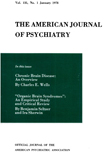Schizophreniform Psychosis of Childhood
Abstract
Twenty-two children were studied who had symptoms that closely correspond to the 1966 GAP description of schizophreniform psychosis: extensive fantasies, impaired reality testing, hallucinations, paranoia, fluctuating ego functioning, and intensely dependent attachments to adults, especially the mother. Unlike most childhood psychoses, this disorder did not appear until early latency. If early psychotherapy, lasting a year or more, was carried out, the prognosis was good. The authors stress the importance of early recognition and treatment of this disorder and urge an end to its neglect in the literature.
Access content
To read the fulltext, please use one of the options below to sign in or purchase access.- Personal login
- Institutional Login
- Sign in via OpenAthens
- Register for access
-
Please login/register if you wish to pair your device and check access availability.
Not a subscriber?
PsychiatryOnline subscription options offer access to the DSM-5 library, books, journals, CME, and patient resources. This all-in-one virtual library provides psychiatrists and mental health professionals with key resources for diagnosis, treatment, research, and professional development.
Need more help? PsychiatryOnline Customer Service may be reached by emailing [email protected] or by calling 800-368-5777 (in the U.S.) or 703-907-7322 (outside the U.S.).



